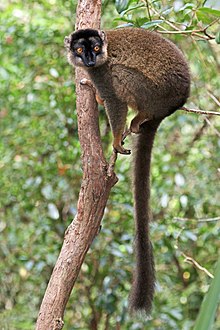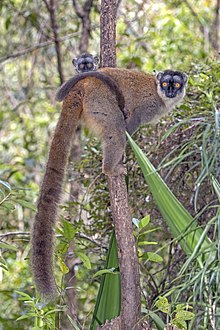
Lemuridae is a family of strepsirrhine primates native to Madagascar and the Comoros. They are represented by the Lemuriformes in Madagascar with one of the highest concentration of the lemurs. One of five families commonly known as lemurs. These animals were once thought to be the evolutionary predecessors of monkeys and apes, but this is no longer considered correct. They are formally referred to as lemurids.

The ring-tailed lemur is a medium- to larger-sized strepsirrhine (wet-nosed) primate, and the most internationally-recognized lemur species, owing to its long, black-and-white, ringed tail. It belongs to Lemuridae, one of five lemur families, and is the only member of the Lemur genus. Like all lemurs, it is endemic to the island of Madagascar, where it is endangered. Known locally in Malagasy as maky or hira, it ranges from gallery forests to spiny scrub in the southern regions of the island. It is omnivorous, as well as the most adapted to living terrestrially of the extant lemurs.
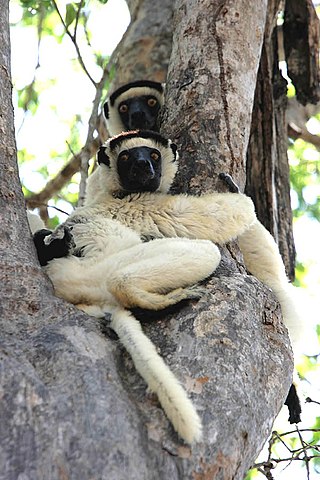
Verreaux's sifaka, or the white sifaka, is a medium-sized primate in one of the lemur families, the Indriidae. It lives in Madagascar and can be found in a variety of habitats from rainforest to dry deciduous forests of western Madagascar and the spiny thickets of the south. Its fur is thick and silky and generally white with brown on the sides, top of the head, and on the arms. Like all sifakas, it has a long tail that it uses as a balance when leaping from tree to tree. However, its body is so highly adapted to an arboreal existence, on the ground its only means of locomotion is hopping. The species lives in small troops which forage for food.

True lemurs, also known as brown lemurs, are the lemurs in genus Eulemur. They are medium-sized primates that live exclusively on Madagascar.

The mongoose lemur is a small primate in the family Lemuridae, native to Madagascar and introduced to the Comoros Islands. These arboreal animals have pointed faces, long, bushy tails, dark-brown upper parts, pale bellies, and beards, which are reddish in males and white in females. They live in family groups and feed primarily on fruit, but also eat leaves, flowers, and nectar, with nectar from Ceiba pentandra trees making up a large part of their diet during the dry season. They have declined sharply in numbers because of habitat destruction and hunting, and the International Union for Conservation of Nature has rated their conservation status as "critically endangered".

Cathemerality, sometimes called "metaturnality", is an organismal activity pattern of irregular intervals during the day or night in which food is acquired, socializing with other organisms occurs, and any other activities necessary for livelihood are undertaken. This activity differs from the generally monophasic pattern of nocturnal and diurnal species as it is polyphasic and is approximately evenly distributed throughout the 24-hour cycle.
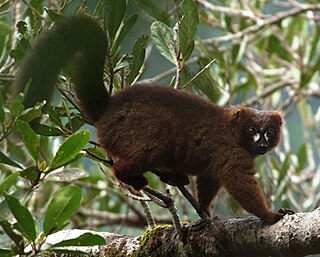
The red-bellied lemur is a medium-sized strepsirrhine primate with a luxuriant chestnut brown coat. This lemur is endemic to eastern Madagascan rainforests and is distinguished by patches of white skin below the eyes, giving rise to a "teardrop" effect, particularly conspicuous in the male.
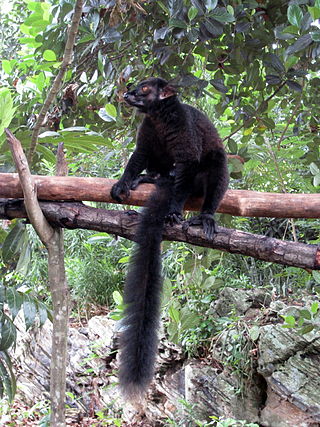
The black lemur is a species of lemur from the family Lemuridae. Like all lemurs, it is endemic to Madagascar. Originally, the species was thought to have two subspecies, Eulemur macaco macaco and Eulemur macaco flavifrons, both of which were elevated to species status by Mittermeier et al. in 2008 to Eulemur macaco and Eulemur flavifrons respectively. The most startling difference between the two species is the eye colour; Eulemur flavifrons, the blue-eyed black lemur, has blue eyes, while Eulemur macaco, the black lemur, has brown or orange eyes, and also has ear tufts.

The blue-eyed black lemur, also known as the Sclater's lemur, is a species of true lemur. It can attain a body length of 39–45 cm (15–18 in), a tail length of 51–65 cm (20–26 in), a total length of 90–100 cm (35–39 in), and a weight of 1.8–1.9 kg (4.0–4.2 lb). Being a primate, it has strong hands with palms like a human, which have a rubbery texture to give it a firm grip on branches. Its tail is longer than its body and is non-prehensile.

The white-headed lemur, also known as the white-headed brown lemur, white-fronted brown lemur, or white-fronted lemur, is a species of primate in the family Lemuridae. It is only found in north-eastern Madagascar. It is arboreal and is usually found in rainforest treetops. It was formerly recognised as a subspecies of the common brown lemur.

The collared brown lemur, also known as the red-collared brown lemur or red-collared lemur, is a medium-sized strepsirrhine primate and one of twelve species of brown lemur in the family Lemuridae. It is only found in south-eastern Madagascar. Like most species of lemur, it is arboreal, moving quadrupedally and occasionally leaping from tree to tree. Like other brown lemurs, this species is cathemeral, lives in social groups, primarily eats fruit, exhibits sexual dichromatism, and does not demonstrate female dominance. The species is listed as Endangered by the International Union for Conservation of Nature (IUCN) and is threatened primarily by habitat loss.

Sanford's brown lemur, or Sanford's lemur, is a species of strepsirrhine primate in the family Lemuridae. Sanford's brown lemur was previously considered a subspecies of the common brown lemur but was raised to full species in 2001. It is named after Leonard Cutler Sanford, a trustee of the American Museum of Natural History.
Tampoketsa Analamaitso Reserve is a wildlife reserve of Madagascar located in the Sofia Region. It covers 17 150 ha in three districts: Port Bergé, Mandritsara and Mampikony.

The southern woolly lemur, or southern avahi, has been recently recognized as a separate species of woolly lemur in 2006 by Zaramody et al. It is a nocturnal and pair-living species. Groups can range from 2 to 5 individuals. A study in Sainte Luce forest revealed home range varied from 2.2 to 3.5 ha and that males can have larger home range and cover longer daily distances than females, in agreement with the territory defence and mate guarding hypotheses.

The red-fronted lemur, also known as the red-fronted brown lemur or southern red-fronted brown lemur, is a species of lemur from Madagascar. Until 2001, it was considered a subspecies of the common brown lemur, E. fulvus. In 2001, E. fulvus was split into several separate species, including Eulemur rufus, in which this species was included. In 2008, E. rufus was split into two species, the red lemur and the red-fronted lemur. E. rufus covers the population on the west coast north of the Tsiribihina River and E. rufifrons covers the population on the west coast south of the Tsiribihina River and the population in eastern Madagascar. The species split was based on genetic and morphological evidence. Mitochondrial DNA analysis indicates that E. rufifrons may be more closely related to the common brown lemur, white-headed lemur and Sanford's brown lemur than it is to E. rufus.

The gray-headed lemur, or gray-headed brown lemur, is a medium-sized primate, a cathemeral species of lemur in the family Lemuridae. Until a taxonomic revision in 2008, it was known as the white-collared brown lemur or white-collared lemur. It lives in south-eastern Madagascar. In 2005, satellite imagery estimates showed approximately 700 km2 (270 sq mi) of total remaining habitat within its geographic range. It is highly threatened by hunting and habitat loss, and was considered to be among the 25 most endangered primates in 2006–2008. It is currently listed as Critically Endangered by the International Union for Conservation of Nature (IUCN) due to a highly restricted range, and has been named one of "The World's 25 Most Endangered Primates."

The red lemur, also known as the rufous brown lemur or northern red-fronted lemur, is a species of lemur from Madagascar. Until 2001, the species E. rufus was considered a subspecies of the common brown lemur, E. fulvus, after which it was classified as its own species. In December 2008, the species was split into two separate species, the red lemur, E. rufus, distributed in dry lowland forests in northwestern Madagascar, and the red-fronted lemur, E. rufifrons, distributed in southwest and eastern Madagascar. The species split was based on genetic and morphological evidence. Mitochondrial DNA analysis indicates that E. rufifrons may be more closely related to the common brown lemur, white-headed lemur and Sanford's brown lemur than it is to E. rufus.
Yves Rumpler, is a French researcher and primatologist. He was a professor of embryology and primatology at the Louis Pasteur University of Strasbourg until he retired in 2007.
